At Roots we rarely recommend electric showers.
For most of our customers, most of the time, non electric showers will perform better. This post will go into the detail of why we don’t recommend them. Even if you’re not looking for a complete bathroom from Roots we hope you’ll find this useful.
Definitions:
Electric showers – Plumbed to cold water only, it heats the cold water with an electric element.
Shower Valve or Shower Mixer – Plumbed to hot and cold water, they mix the two to control the temperature.
Power shower – a shower that has a pumped water supply to increase water pressure. This applies to both electric or mixer valve. The pump can be part of an electric shower mounted on the wall (noisy!) or remote from the shower (often in a loft or airing cupboard). In the UK you can only pump from stored water tanks (“gravity heating systems”). If you have a mains pressure system or a combi boiler you don’t need a pump. If you have an electric shower supplied from the cold water main you don’t need a pump.
Digital/Smart Showers – Just like the shower valves/shower mixers but instead of a mechanical valve you turn, it’s a digital control to a remote mixing unit. There can be advantages to this approach, including:
- Easier to use controls (less resistance to moving or simple on/off buttons, including some with wireless remote control buttons. I’ve not seen them yet but I’m sure that voice control of showers is possible too).
- More options for plumbing, allowing for the mixing unit to be easier to access for servicing and maintenance.
Thermostatic – for completeness let’s mention this word. These are shower mixers so that if the cold water flow slows you don’t get scalded by hot water. In my opinion you should only choose thermostatic mixers. This is for the safety of all who use the shower in the future. I believe there are few good reasons to specify a non-thermostatic mixer.
What is a good shower (and how do we know?)
This is a complicated question! Partly, it’s subjective – what you consider a good shower will be different to what I consider a good shower. Partly, there are too many variables to summarise in a single number. Performance is a combination of
- flow rate (is there enough water to wash in),
- temperature (is it warm enough to be nice),
- pressure (do you like a shower softer than rain or a deluge that strips your skin after a day of oily engineering work)
- functional design (how does the shower head you’re using spread the water over you).
Writing this part of the post has now taken me 5 hours of research but the good news is you get the executive summary.
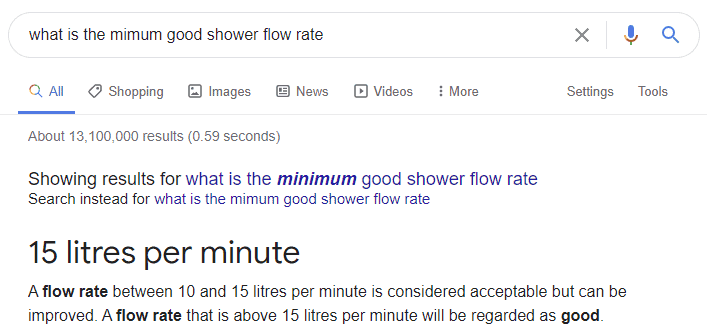
To start with, I’m going to consider just flow rate and ask google ‘what is the minimum good shower flow rate?’: Answer – 15 litres per minute
Which is interesting because before researching this post thought 8 litres a minute was good.
So I tested my shower at home (which I like a lot) and on the flow setting I normally use (number 6 from a maximum of 7) it delivered 10 litres per minute.
That tells me I could comfortably accept less… so how much less? I turned the shower down to setting 1, the minimum flow rate. I decided that it felt like a good minimum for me and I wouldn’t choose less. Good for me means there was no great pressure left in the flow of water but it did get me comfortably wet. It was still better than the shower at my in-laws home [1] (a footnote at the end, they tested it for me) but no longer a shower I’d look forward to after a weekend of hiking. Setting 1 delivered 6 litres per minute.
What about the shower standards set by governments?
Standards for flow rates are based around energy saving and water efficiency rather than how good a shower feels.
In the USA the National Energy Policy Act of 1992 mandates a maximum flow rate of 9.5Lpm (or 2.5 US gallons per minute) and there’s a water saving label scheme called “Watersense” that limits the maximum to 7.6Lpm (2 US Gallons per minute).
In Europe we like our energy saving labels to help us differentiate products and the http://www.europeanwaterlabel.eu/ provides us with a common standard to be met for a shower to be A rated. Now the focus here is not on what feels great, but on running costs and water usage. As a benchmark I’m going to assume the flow rating here for an A rated shower may feel adequate rather than great, but it gives me a lower bound on what an acceptable rate is. Obviously I’d love a great shower to use less than 1 litre of water per minute but that’s not realistic.
The energy label defines an A rated shower as 6 litres per minute or less. For a B rated shower up to 8 litres per minute or less [2]
I’m getting more comfortable in claiming that, for me, “A good shower needs at least 6 litres of water per minute”, obviously that’s with all the caveats of pressure, shower head design and water temperature. I could also say “A shower with less than 6 litres of water per minute is probably OK but probably not meeting my definition of good”.
How good can an electric shower be?
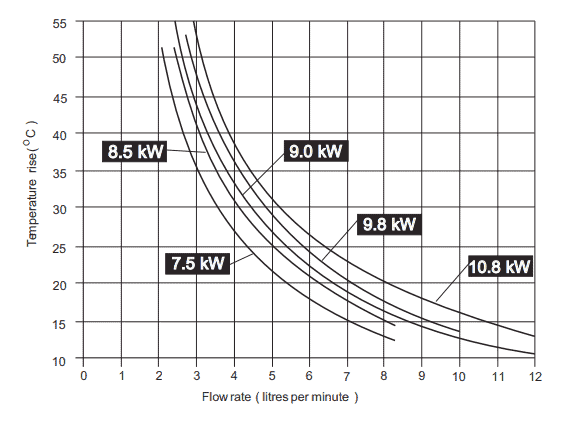
Thanks to Science(Physics)™ we know a thing or two about how to measure energy. Its mundane enough to be taught in GCSE science and complicated enough I spent more than an hour reminding myself how the different numbers relate to each other in order to understand the relationship.
I found a great guide from Mira (a shower manufacturer) that explains electric showers in detail and it includes a flow rate graph showing for different electric shower power ratings how much heat can be added to water in litres per minute.
I also found this report by United Utilities (Richard Critchley) and Liverpool John Moore University (Dr David Phipps) that included the formula for working out the flow rate for any given temperature increase and power rating (which saved me from having to work it out myself – my physics memory is a little rusty!)
Flow-rates for electric showers typically range between 3 l/min and 8 l/min, and can be calculated from the following equation:-
Flow-rate (litres/minute) = 14.3 * KW rating / Temperature rise (deg C)
My shower at home is set to 39 degrees C. Incoming water temperature varies during the year but today, at the end of March 2021, I’m measuring the incoming water at 7.5 degrees C. So for a shower today I’m looking for a temperature rise of 31.5 Deg C
Assume I buy the most powerful electric shower, will I get at least 6 litres per minute from it today?
14.3 * 10.8kW / 31.5 = 4.9Litres Per Minute.
No. I won’t.
And it gets worse, because at times during the year the incoming water main will be colder, lets say that’s 3 degrees C. Lets also say I like the water hotter (the EU Water label uses 42 deg C in it’s calculations). I need to raise the temperature by 39 Degrees C
14.3 * 10.8kW / 39 = 3.96 Litres per minute
To have the best electric shower I’ll be using around 45-50Amps. If a house typically has a 100A supply then 2 electric showers at the same time as other electrics in the house become impractical. You also have to install a suitably large electric cable for 10.8kW. There’s a good reason so many electric showers use less than 10.8kW. If you have a 7.5kW shower (around 32 amps) my cold winter shower flow rate reduces further to 14.3 * 7.5kW / 39 = 2.75 Litres per minute.
The short answer is, we find that many times during the year we can say an electric shower is functional, but we cannot say that it is good.
So what is better than electric?
Heating water takes a lot of energy.
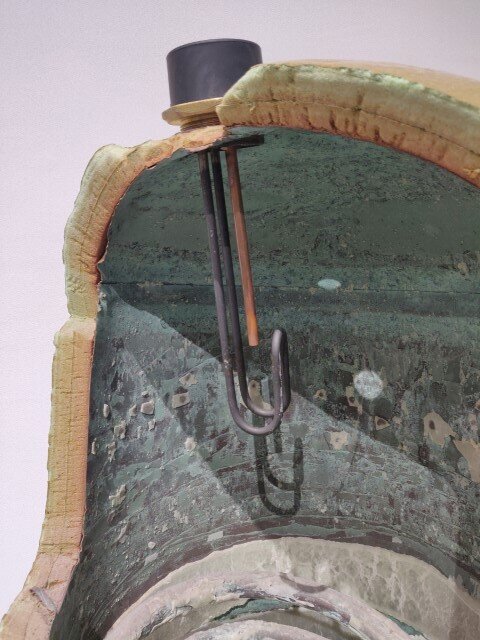
If you can’t provide that energy fast enough then you can spread the same total energy over a longer period of time. This is what happens in a hot water cylinder. Storing water in a well insualted cylinder to reduce heat loss and heating the water slowly.. You can heat this with an electric immersion element like the 3kW element in this cut away cylinder, much smaller than the elements in an electric shower.
A cylinder you say – isn’t that normally connected to the gas boiler (in the UK)?
Why yes it is! Gas is currently cheaper than electric at heating water and our homes. We heat water in a boiler then send it through the hot water cylinder to heat the water for our shower, slowly, over a period of time. When our boiler breaks down we can use the immersion element to still have hot showers.
Have a big enough boiler and you can heat water quickly on demand which is what a combi boiler does. Combi boilers still have their limits though and generally are not used in homes with more than one bathroom used at the same time. As we’ve generally already got a boiler for our central heating, from a performance point of view, stored hot water and combi boilers outperform instantaneous electric showers.
So When do we recommend electric showers to customers?
* When we cant access stored hot water
* When we can’t justify the extra cost of adding or accessing stored hot water. For example occasional use guest rooms when it’s too expensive or not possible to route hot water pipes.
Footnotes
[Footnote 1]
My in-laws tested their electric power shower for me. It’s heating water via electric only and it’s fed from a tank of cold water so has a pump.
- Incoming 12 deg C (from the loft tank)
- Outgoing: 28 deg C …that’s too cold so let’s just assume it was hot enough to compare. Perhaps it cooled quickly before they could take the temperature.
- 5 Litres in 1m17s = 3.9 litres per minute.
As I said, the shower at my in-laws is not a great shower ¯\_(ツ)_/¯
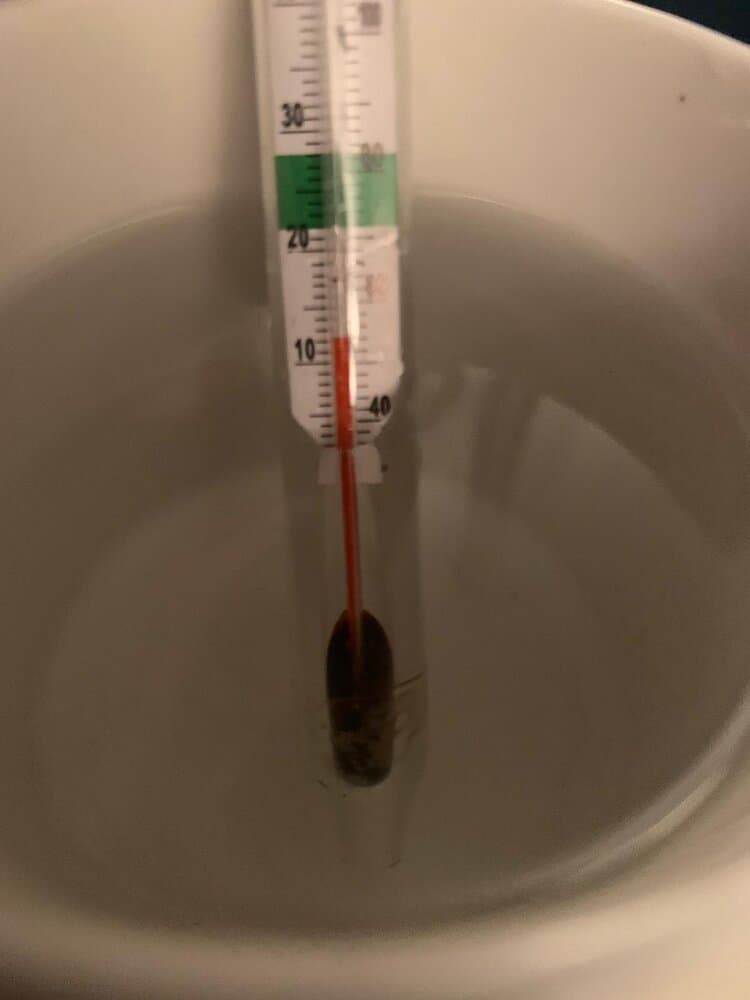
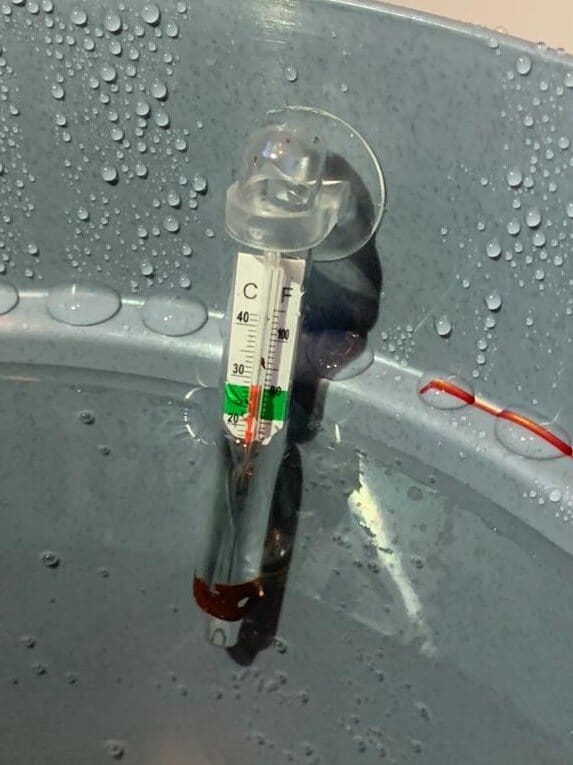
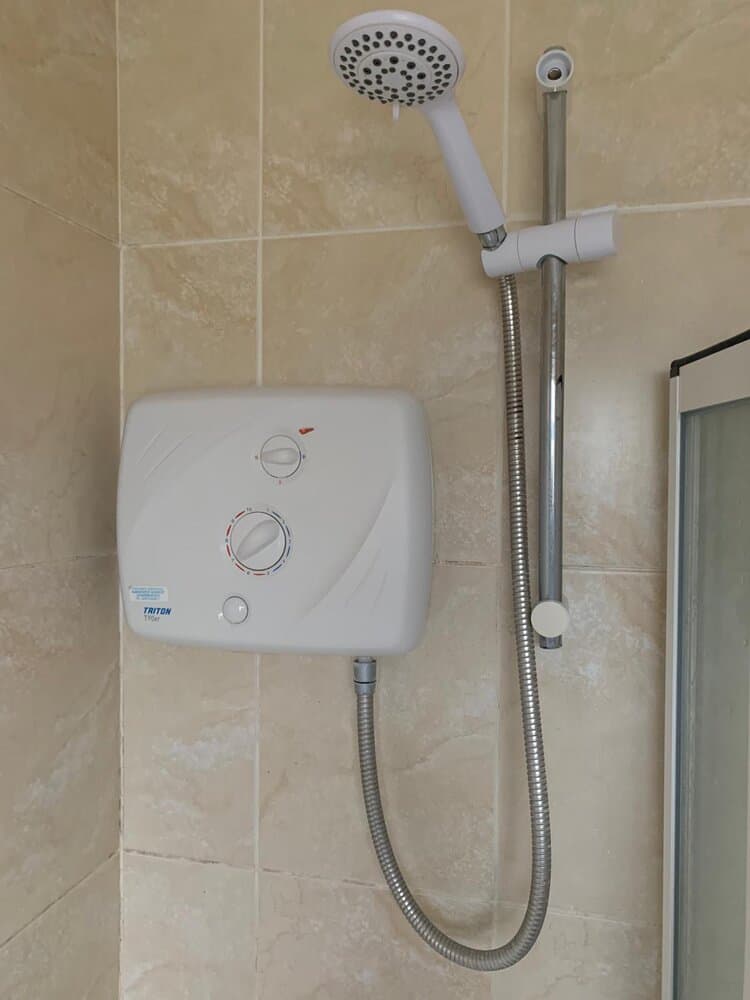
[Footnote 2]
The EU Unified Water Label standard defines every electric shower as A rated automatically. This is becase the flow rates don’t exceed 6 litres per minute in normal usage.
http://www.europeanwaterlabel.eu/pdf/scheme-december2019.pdf
5.5.2 Scope and Objective
Electric showers deliver hot water at a flow rate as a function of their design primarily based upon the energy rating of the heating element contained within the shower (heating) unit. The flow rate is further affected by incoming water temperature and the desired set temperature of the outlet water. The relationship of all these factors is identical for all designs of electric showers. Physical testing is therefore not needed to validate the flow rates of these products
….
To further ‘commonise’ the parameters used for the calculation the inlet temperature and outlet temperature values are selected to be mid-values that essentially cover seasonal variation between winter and summer operation of these products.
For the purposes of this Scheme, the following seasonally adjusted values shall be: –
Outlet set temperature 42°C;
Inlet supply temperature 15°C;
In all cases the operating voltage shall be 240 volts.
The calculation method validates all existing known electric shower products as ‘eco’ or ‘low flow’ i.e. less than 6 litres per minute.
E.g.7.0 kW nominal rating at 240V will calculate to 3.72 l/m
8.0 kW nominal rating at 240V will calculate to 4.25 l/m
9.0 kW nominal rating at 240V will calculate to 4.78 l/m
